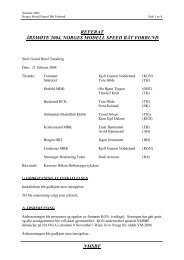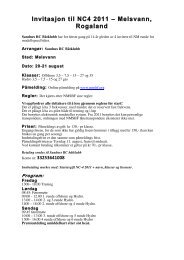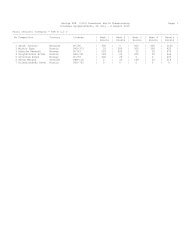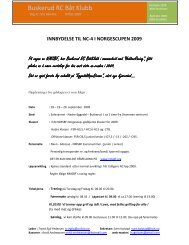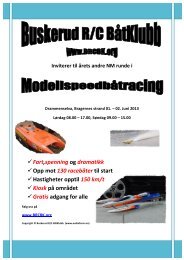Naviga 2009 Rules FSR-O-2003 A.pdf - nmsbf
Naviga 2009 Rules FSR-O-2003 A.pdf - nmsbf
Naviga 2009 Rules FSR-O-2003 A.pdf - nmsbf
Create successful ePaper yourself
Turn your PDF publications into a flip-book with our unique Google optimized e-Paper software.
Competition <strong>Rules</strong><strong>2003</strong><strong>FSR</strong>-OOFFSHOREIssued by the <strong>FSR</strong> Section of <strong>Naviga</strong>Februar <strong>2003</strong>NAVIGAWorld Organisation for Model shipbuilding and Model ship sportWeltorganisation für Schiffsmodellbau und SchiffsmodellsportOrganisation Mondaile de Navimodelisme et de Sport NautiqueNAVIGA <strong>FSR</strong>-O rules <strong>2009</strong> PS111108 Page 1 of 18
NAVIGAWorld Organisation for Model Ship Building and Model Ship SportWeltorganisation für Schiffsmodellbau und SchiffsmodellsportOrganisation Mondaile de Navimodelisme et de Sport NautiqueNAVIGA - Competition <strong>Rules</strong> <strong>2003</strong>Categories <strong>FSR</strong> - OAmendments,additions and proposals for improvements are to be directed to the NAVIGASection Management via the representative of the country.This version is copied from the <strong>FSR</strong>-H and <strong>FSR</strong>-V rulebook. The paragraphs that are valid from thatbook are blanked in this version. Just to get it easier to copy this version into that book when this isready.The NAVIGA Executive CommitteeAmended 02-02-2005NAVIGA <strong>FSR</strong>-O rules <strong>2009</strong> PS111108 Page 2 of 18
CONTENTS:Page:1 DEFINITION OF MODELS ...................................................................AMENDED 01-01-2007 52 CLASSES .......................................................................................................... 53 PRINCIPAL AND GENERAL RULES............................................................... 63.1 Principal <strong>Rules</strong> .............................................................................................................................................. 63.1.1 Competitions where the rules apply ............................................................................................................ 63.1.2 Entry Fee..................................................................................................................................................... 63.1.3 Protest Fees................................................................................................................................................. 63.2 Personal <strong>Rules</strong>............................................................................................................................................... 63.2.1 Age Groups................................................................................................................................................. 63.2.2 Competitor registration ............................................................................................................................... 63.2.3 Maximum Allowed Competitors............................................................................ Amended 02-02-2005 63.2.4 Assistants and substitution of the competitor.............................................................................................. 63.3 Technical rules .............................................................................................................................................. 63.3.1 Propulsion of models and fuels................................................................................................................... 63.3.2 Fuel ............................................................................................................................................................. 63.3.3 Noise reduction, noise level measurement and rules Amended .............................................01-01-2007 63.3.4 Application and use of radio control equipment and frequency control...................................................... 73.3.5 Time Measuring.......................................................................................................................................... 73.3.6 Buoys (Dimensions, Construction, Anchorage) .......................................................................................... 73.3.7 Starting pontoon (Construction and Materials)........................................................................................... 73.4 Sport <strong>Rules</strong> .................................................................................................................................................... 73.4.1 The Competition Area .................................................................................................................................. 73.4.2 Starting area, the preparation area and access permission .......................................................................... 73.4.3 Allowed Number, Entry Possibilities and Race Conditions of the Models................................................. 73.4.4 Re-run of a race........................................................................................................................................... 73.4.5 Registration Numbers .......................................................................................... Amended 01-01-2007 73.4.6 Registration of competitors and models...................................................................................................... 83.4.7 Issuing of starting permits, issuing start and competitor passes .................................................................. 83.4.8 Surrender of competitor passes and Assessment of Running Order............................................................ 83.4.9 Calling time (Time Allowed to Get Ready) ................................................................................................ 83.4.10 Preparation times (at the Starting Point) ..................................................................................................... 83.4.11 Interruption / suspensions of the competition (re 6.5.20).......................................................................... 83.4.12 Scoring and Announcement of the Results.................................................................................................. 83.4.13 Checking of the first three placed models during World and Continental Championships......................... 83.4.14 Awarding of titles at World and Continental Championships..................................................................... 83.4.15 Award Ceremonies at World and Continental Championships................................................................... 83.4.16 Result lists................................................................................................................................................... 83.5 NAVIGA – Protest Policy............................................................................................................................. 93.5.1 Principal <strong>Rules</strong>............................................................................................................................................ 93.5.2 Lodging of protests ..................................................................................................................................... 93.5.3 Handling of Protest ..................................................................................................................................... 93.6 The Model – Measurement Certificate ....................................................................................................... 93.7 General rules regarding construction for category <strong>FSR</strong> ........................................................................... 94 GENERAL RULES REGARDING THE SET UP OF COMPETITION COURSESFOR THE CATEGORY <strong>FSR</strong>.............................................................................. 95 GENERAL RULES REGARDING START AND TERMINATION OF A RACE ORHEAT .................................................................................................................. 9NAVIGA <strong>FSR</strong>-O rules <strong>2009</strong> PS111108 Page 3 of 18
6 COMPETITION REQUIREMENTS IN <strong>FSR</strong> CATEGORY..................................... 96.1 General construction rules and regulations .......................................................... Amended 01-01-2007 96.2 Manning Level of the Start Pontoon......................................................................................................... 116.3 Minimum requirements for the starting area................. Amended 02-02-2005 Amended 01-01-2007 116.4 Competition course and duration of the race in the <strong>FSR</strong>-V Classes ...................................................... 116.5 Procedures for Races in the <strong>FSR</strong>-V Classes ............................................................................................. 116.6 Lap Counting for <strong>FSR</strong>-V races.................................................................................................................. 116.6.1 Manual lap counting .................................................................................. Error! Bookmark not defined.6.6.2 Computerised lap counting ....................................................................................................................... 116.7 Scoring in <strong>FSR</strong>-V classes............................................................................................................................ 116.8 Composition of Result Lists in the <strong>FSR</strong>-V classes.................................................................................... 116.9 Competition course and duration of a race in the <strong>FSR</strong>-H classes........................................................... 116.10 Start clock for <strong>FSR</strong>-H classes................................................................................ Amended 02-02-2005 116.11 Procedures for races in the <strong>FSR</strong>-H classes ............................................................................................... 126.12 Basic rules and penalties in the <strong>FSR</strong>-H classes......................................................................................... 126.12.1 Left Turns ................................................................................................................................................. 126.12.2 Right of Way............................................................................................................................................. 126.12.3 Negotiating/passing the buoys .................................................................................................................. 126.13 <strong>Rules</strong> for overtaking in the <strong>FSR</strong>-H classes................................................................................................ 126.14 Calculation of final results in the <strong>FSR</strong>-H classes...................................................................................... 126.15 Composition of result lists in the <strong>FSR</strong>-H classes ........................................ .... Amended 02-02-2005 126.16 Competition course and duration of a race in the <strong>FSR</strong>-O classes...................... Amended 01-01-2007 136.17 Procedures for races in the <strong>FSR</strong>-O classes. Amended 02-02-2005 Amended 01-01-2007 136.17 Procedures for races in the <strong>FSR</strong>-O classes. Amended 02-02-2005 Amended 01-01-2007 146.17 Procedures for races in the <strong>FSR</strong>-O classes Amended 2005-2007 Amended 01-01-<strong>2009</strong> 156.18 Lap Counting for <strong>FSR</strong>-O races……….................................................................. Amended 01-01-2007 166.18.1 Computerised lap counting ................................................................................. Amended 01-01-2007 166.19 Scoring in <strong>FSR</strong>-O classes............................................................................................................................ 166.20 Composition of Result Lists in the <strong>FSR</strong>-O classes.................................................................................... 177 METHODS FOR MEASURING NOISE LEVELS IN THE <strong>FSR</strong> CATEGORY 177.1 General ........................................................................................................................................................ 177.2 Measuring methods in <strong>FSR</strong>-H classes ....................................................................................................... 177.3 Measuring methods in <strong>FSR</strong>-V/O classes 17Drawing 4 a Offshore Amended 02-02-2005 Amended 01-01-2007 18NAVIGA <strong>FSR</strong>-O rules <strong>2009</strong> PS111108 Page 4 of 18
1 Definition of modelsModels in the <strong>FSR</strong> categories are controlled by the competitor using radio control. These aremodel boats of free design, which conform to the race requirements, however should in formand design look like a boat.Offshore boats are deep vee or tunnel hull with surface or semi-surface drive. Hydro-planeor other three or more planning surface are not allowed.2 ClassesThe category <strong>FSR</strong> can be divided into the following groups and classes:Class <strong>FSR</strong>-H3.5Class <strong>FSR</strong>-H7.5Class <strong>FSR</strong>-H15Class <strong>FSR</strong>-V3.5Class <strong>FSR</strong>-V7.5Class <strong>FSR</strong>-V15Class <strong>FSR</strong>-V35Free build HYDRO - planes* with internal combustion motor up to3.5 cm 3 and with surface drive propulsion.Free build HYDRO - planes* with internal combustion motorabove3.5 cm 3 up to 7.5 cm 3 and with surface drive propulsion.Free build HYDRO - planes* with internal combustion motor above7.5 cm 3 up to 15. cm 3 and with surface drive propulsion.Free build racing models for endurance races (20 – 30 min) withinternal combustion motors up to 3.5 cm 3 and below waterlinepropulsion.Free build racing models for endurance races (20 – 30 min) withinternal combustion motors above 3.5 up to 7.5 cm 3 and belowwaterline propulsion.Free build racing models for endurance races (20 – 30 min) withinternal combustion motors above 7.5 up to 15.0 cm 3 and belowwaterline propulsionFree build racing models for endurance races (20 – 30 min) withinternal combustion motors (petrol-motor with spark plug ignition)above 15.0 up to 35.0 cm 3 and below waterline propulsion.Class <strong>FSR</strong>-O3.5 Free build offshore boats with internal combustion motors up to 3.5cm 3 . and with surface drive propulsion.Class <strong>FSR</strong>-O7.5 Free build offshore boats with internal combustion motors above 3.5up to 7.5.cc.and with surface drive propulsion.Class <strong>FSR</strong>-O15 Free build offshore boats with internal combustion motors above 7.5up to 15.0 cm 3 . and with surface drive propulsion.Class <strong>FSR</strong>-O35Free build offshore boats with internal combustion motors (petrolmotorwith spark plug ignition) above 15.0 up to 35.0 cm 3 . and withsurface drive propulsion.Remark:* HYDRO-planes (A free build model with two or more planing surfaces).Amend 01-01-2007NAVIGA <strong>FSR</strong>-O rules <strong>2009</strong> PS111108 Page 5 of 18
3 Principal and General <strong>Rules</strong>3.1 Principal <strong>Rules</strong>3.1.1 Competitions where the rules apply3.1.2 Entry Fee3.1.3 Protest Fees3.2 Personal <strong>Rules</strong>3.2.1 Age Groups3.2.2 Competitor registration3.2.3 Maximum Allowed Competitors(1) At the world championships each country is allowed to enter the following number ofcompetitors in seniors and juniors:In the <strong>FSR</strong>-O classes 3 competitors and the title defendant.In the <strong>FSR</strong>-O classes it can be more,if one country have a competitor in the final thecountry have the richt for 1 extra place in the next worldchampionship.If they have 2 in thefinal than they have 2 extra place’s for the next worlchampionship,in this case they have thericht for 5 competitors.The maximum is 5 competitors and the title defendant.(2) In continental championshipsIn the <strong>FSR</strong>-O classes each 5 competitors and the title defendant3.2.4 Assistants and substitution of the competitor3.3 Technical rules3.3.1 Propulsion of models and fuels3.3.2 Fuel(1) Free fuel is allowed except in the <strong>FSR</strong>-V35 and <strong>FSR</strong>-O35 class.(2) Fuel in the <strong>FSR</strong>-V35 and <strong>FSR</strong>-O35 class must be a petrol-oil mixture.Petrol can be of any octane level.The use of Methanol mixtures is prohibited.3.3.3 Noise reduction, noise level measurement and rules(1) (2) (3) (4) (5)(6) For the method of measuring noise levels in classes <strong>FSR</strong>-H, <strong>FSR</strong>-V and <strong>FSR</strong>-Orefer to paragraph 7.Amended 01-01-2007NAVIGA <strong>FSR</strong>-O rules <strong>2009</strong> PS111108 Page 6 of 18
3.3.4 Application and use of radio control equipment and frequency control3.3.5 Time Measuring3.3.6 Buoys (Dimensions, Construction, Anchorage)3.3.7 Starting pontoon (Construction and Materials)3.4 Sport <strong>Rules</strong>3.4.1 The Competition Area3.4.2 Starting area, the preparation area and access permission3.4.3 Allowed Number, Entry Possibilities and Race Conditions of the Models(1) .(2) .(3) For entry of a model in other classes the following rules apply:(4)An offshore boat is not allowed to start in any other <strong>FSR</strong> category in the same competition.3.4.4 Re-run of a race3.4.5 Registration Numbers(1) At all NAVIGA events all models must have fixed registration numbers on the hull.(2) The respective country gives out the registration numbers. If the nationality is not part of theregistration number it must be attached to the models. Registration numbers and nationalitymust not be changed and must be permanently fixed on the hull.(3) The race and spare model must show an identical registration numbers.Boat– upper deck XYZ = NationalityH3 = National Registration NumberAmended 01-01-2007NAVIGA <strong>FSR</strong>-O rules <strong>2009</strong> PS111108 Page 7 of 18
3.4.6 Registration of competitors and models3.4.7 Issuing of starting permits, issuing start and competitor passes3.4.8 Surrender of competitor passes and Assessment of Running Order3.4.9 Calling time (Time Allowed to Get Ready)3.4.10 Preparation times (at the Starting Point)3.4.11 Interruption / suspensions of the competition (re 6.5.20)3.4.12 Scoring and Announcement of the Results3.4.13 Checking of the first three placed models during World and ContinentalChampionships(1)(2) In the <strong>FSR</strong>-V and <strong>FSR</strong>-O classes, with exception of the <strong>FSR</strong>-V/O35 class, preliminarychecks after the heats can be done to assess the exact capacity of the engines.(3) In the <strong>FSR</strong>-V/O35 class the measurement of the cylinder capacity of the first three placedmodels is done on the basis of the construction particulars after the completion of the finals.(4)(5)(6)(7)3.4.14 Awarding of titles at World and Continental Championships3.4.15 Award Ceremonies at World and Continental Championships3.4.16 Result listsFor special regulations regarding the contents of the result list refer to sections 6.8. for <strong>FSR</strong>-V, 6.15 for <strong>FSR</strong>-H and 6.20 for <strong>FSR</strong>-O.Amended 01-01-2007NAVIGA <strong>FSR</strong>-O rules <strong>2009</strong> PS111108 Page 8 of 18
3.5 NAVIGA – Protest Policy3.5.1 Principal <strong>Rules</strong>3.5.2 Lodging of protests3.5.3 Handling of Protest3.6 The Model – Measurement CertificateFor model classes <strong>FSR</strong>-H, <strong>FSR</strong>-V and <strong>FSR</strong>-O no international model –measurementcertificate is required.3.7 General rules regarding construction for category <strong>FSR</strong>(1) For competitions in category <strong>FSR</strong> models are of free design (see definition in section 1).The model however must be owned by the competitor.(2)(3)(4)4 General <strong>Rules</strong> regarding the set up of competition courses for the category <strong>FSR</strong>(1) The competitions in the category <strong>FSR</strong> are performed on two different courses.(2)- For the <strong>FSR</strong>-H category see drawing 4- For the <strong>FSR</strong>-V category see drawing 3- For the <strong>FSR</strong>-O category see drawing 4 a5 General <strong>Rules</strong> regarding start and termination of a race or heat6 Competition requirements in <strong>FSR</strong> category6.1 General construction rules and regulations(1)(2)(3) Every model must have on the deck a longitudinal mount for attaching number plate that canbe provided by the organisation. The number plate must be made out of flexible and durablematerial, which does not cause damage to the model when run over. The plate must be whiteand the numbers from 1 to 10 must be black. The number plate must be attached to themodel with two connections.The number plate for <strong>FSR</strong>-O must be mounted on the left handside.It is allowed the use the own number plate if they are according to the rules.NAVIGA <strong>FSR</strong>-O rules <strong>2009</strong> PS111108 Page 9 of 18
(4) The dimensions of number plates for category <strong>FSR</strong> are as follows (see drawing 2):- Height 100 mm- Width 120 mm- Thickness approx. 2 mm- Distance between the holes 100 mm- Distance of hole from the bottom of plate 10 mm- Diameter of hole 5 mmThe corners of theshield must berounded offDrawing 2:Number plate for category <strong>FSR</strong>.(5)(6)(7)(8) In classes <strong>FSR</strong>-H and <strong>FSR</strong>-O the rescue of models is only performed after completion of theheat. In <strong>FSR</strong>-O you are allowed to pickup your boat by your self from within the pontoon onyour one place and restart.(9)(10)(11)(12)(13)Amended 01-01-2007NAVIGA <strong>FSR</strong>-O rules <strong>2009</strong> PS111108 Page 10 of 18
(14) <strong>FSR</strong>-V35 boats must have a towing eye on the front for recue purposes.(15)6.2 Manning Level of the Start Pontoon6.3 Minimum requirements for the starting areaThe minimum requirements for a starting area in the <strong>FSR</strong> category are:A starting pontoon for <strong>FSR</strong>-V class should be minimum 19,5 meters long and 1.5 meterswide, with numbered starting positions from 12 – 1. In the <strong>FSR</strong>-H class the starting pontoonshould be minimum 12 meters long and 1.5 meters wide, with numbered starting positionsfrom 1 – 8 <strong>FSR</strong>-O numbered starting positions1 - 102 sets of number plates with the numbers 1 to 12 for <strong>FSR</strong>-V and 1 to 8 for <strong>FSR</strong>-Hfor <strong>FSR</strong>-O 1 to 10.6.4 Competition course and duration of the race in the <strong>FSR</strong>-V Classes6.5 Procedures for Races in the <strong>FSR</strong>-V Classes6.6 Lap Counting for <strong>FSR</strong>-V races6.6.1 Computerised lap counting6.7 Scoring in <strong>FSR</strong>-V classes6.8 Composition of Result Lists in the <strong>FSR</strong>-V classes6.9 Competition course and duration of a race in the <strong>FSR</strong>-H classes6.10 Start clock for <strong>FSR</strong>-O classes may be also supplemented by a digital diplay(1) The start clock is designed for <strong>FSR</strong>-O races with special optical and acoustical informationand signals, which the competitors use to prepare for the start of the heat.Amended 02-02-2005Amended 01-01-2007NAVIGA <strong>FSR</strong>-O rules <strong>2009</strong> PS111108 Page 11 of 18
Drawing 5:Start clock for <strong>FSR</strong>-O races.(2) The start clock must comply with the following:1 turn of the hand must be 30 seconds with a precision of approx. 1 second.The face of the clock must show the following points: 15 seconds, 7.5 seconds, 5, 4, 3, 2 ,1seconds.The 5-second segment must be shown in a contrast colour.There must be 4 red lights, which are all switched on at the beginning of preparation time.The lights will be switched off individually at 30-second intervals.After the last red light has gone off a yellow light will come on which indicates the 30seconds control time when no boats can be launched. At the end of this 30 seconds a whitelight or acoustic signal will indicate the start of the race.The clock hand must reach the “12 o’clock” position at exactly the same time as the light oracoustic signal indicates the start of the race.The face of the clock must be white or orange, the hand must be black.The diameter of the face of the clock must be between 750 and 1000 mm.The start clock must be able to float so that it can be positioned within the competitioncourse.6.11 Procedures for races in the <strong>FSR</strong>-H classes6.12 Basic rules and penalties in the <strong>FSR</strong>-H classes6.12.1 Left Turns6.12.2 Right of Way6.12.3 Negotiating/passing the buoys6.13 <strong>Rules</strong> for overtaking in the <strong>FSR</strong>-H classes6.14 Calculation of final results in the <strong>FSR</strong>-H classes6.15 Composition of results in the <strong>FSR</strong>-H classesAmended 02-02-2005NAVIGA <strong>FSR</strong>-O rules <strong>2009</strong> PS111108 Page 12 of 18
6.16 Competition course and duration of a race in the <strong>FSR</strong>-O classes(1) The competition will be held on a course as shown in drawing 4.a The competition coursehas to be placed so that the base line runs parallel to the starting pontoon.Lapcounter and finish line have to be on the leftside hand side of the pontoon1---------10 = Start positionsRB = Recue boatSC = Start clockLC = Lapcounting(2) Starting time for the heat has to be shown on a start clock (see drawing 5) or other adequate(optical or acoustic) means (see 6.10 for start clock).6.17 Procedures for races in the <strong>FSR</strong>-O classes(1) The Offshore classes are running 2 heats on a day and the follow order will be on thismanner 3.5J, 3.5S, 7.5J, 7.5S, 15J, 15S, 35S, and round again.(2) A heat must have a minimum of 4 and maximum of 10 competitors. Each competitor mustrun at least 4 heats.If there are more than 10 competitors entered in a class, a final must berun in accordance with paragraph (3).(3) A heat shall be so composed that the competitors will be mixed in the heats as much aspossible. Also the place on the pontoon shall be randomly.(4) 10 competitors with the highest scores from the heats qualify for the final. For the final oneheat is to be run. The best placed competitor will occupy start position 1, the second bestplaced start position 2, the third best placed start position 3, and so on till place 10.(5) Before the start of each heat a radio check has to be carried out to prevent interference.Therefore all transmitters and receivers must be switched on. When it has been confirmedthat there is no radio interference it is no longer possible to protest. ( point 6.5 (5) <strong>FSR</strong>/V)(6) Each race consists of three independent phases:Preparation time (Pit time) 2 minutesControl time (Milling time) 30 secondsCourse time (Race time) 8 minutes for qualification and 12 minutes for finalAmended 02-02-2005Amended 01-01-2007NAVIGA <strong>FSR</strong>-O rules <strong>2009</strong> PS111108 Page 13 of 18
(7) During preparation time engines are started, and the boats launched. Races cannot berepeated. Preparation time must not be delayed or cancelled, unless in exceptionalcircumstances at the judges discretion (e.g. problems on the racecourse). Models can beadjusted during the preparation time, however the competitor is not allowed to leave the startposition.(8) During the control time no further boats can be launched. During the course time thecompetitiors are allowed for after start.(9) The competitor should have 1 minimum milling lap.If the boat is not in the water at thewhite light the judge will be given the competitor 1 penalty lap.(10) The competitors must drive their boats around the course or the special lay-by zoneallocated by the competition management, so that all the competitors can cross the start lineat the end of control time. Boats must drive the course in the clockwise direction.(11) During the last 15 seconds of the control time in order to ensure the safety of all the boats,the models must keep in a straight line after passing buoy No 6. Zigzagging across thecourse, course changes in excess of 45 degrees in order to avoid crossing the start line earlyetc., are not allowed and are penalised with a one lap off.(12) The end of the control time indicates the start of the race time, regardless of where the boatsare on the course.(13) Models crossing the start line immediately before the end of control time have a false startand must therefore complete an extra lap.(14) <strong>FSR</strong>-O boats can be repaired and/off refuelled during a heat. Only laps completed during theheat will be counted.(15) For repairing or refuelled the boat must come in with a running engine.(16) During the racetime you may leave the start position to pickup the model or to fetch sparematerials. However while driving the competitor must not leave the start position. It is notallowed to remove the transmitter from the start position.(17) All buoys must be negotiated in accordance with the course. Touching the buoys is allowed.Only those laps negotiated in accordance with the course are counted.Running over the buoythe lap will be not counted.(18) During the race each competitors laps must be displayed on a scoreboard.(19) If a buoy is passed on the wrong side, it is allowed to re circle the buoy without interferingwith other competitors. If you do not re circle the buoy the lap will not be counted.(20) A slower boat can be overtaken on either side. During the overtaking manoeuvre the slowerboat must not change course or get in the way of the overtaking boat. The overtaking boatcan return to the racing line when no less then three boat lengths ahead.The faster boat is not allowed to interfere with the slower model during the overtaking manoeuvre.Amended 01-01-2007NAVIGA <strong>FSR</strong>-O rules <strong>2009</strong> PS111108 Page 14 of 18
(21) The boat on the race line, which is less than 5 boat lengths from a buoy, has right of way.A manoeuvre to force a boat to pass on the inside of a buoy in order to overtake is notpermitted.(22) If a boat looses the numberplate during the race it is allowed to complete the commencedlap. Any laps completed after this lap without a number plat will not be counted.(23) A race can be stopped by the start position official due to exceptional circumstances (e.g.sheered off buoys). <strong>Rules</strong> for stopping a race:a) The start position official gives an acoustic signal about the same as at the end of a race.At the same time as the signal is given the clock which measures the duration of the raceis stopped. After the start position official has given the signal, the models have tocomplete the commenced lap and this lap will be counted.b) The time, from when the signal was given, until the models pass the finish line, must berecorded. The models have to be taken from the water and the engines stopped.c) Competitors and assistants have to step back from the models. Repairs are notpermitted. During the interruption in the race models can be rescued.d) Rescued boats are not allowed to restart.e) After resolving the cause for the interruption, the start position official will give a startsignal. The time keeping will continue with the start signal.f) If the race is stopped within the first three minutes it will be annulled and restarted fromthe beginning.(24) If a heat had to be stopped, all the laps and times have to be added together.(25) In cases of unfair behaviour, interference with other competitors, not following the rules orendangering spectators (e.g. collision with the starting pontoon)(to fast within 3 mtr.from thepontoon a yellow safety card) the start position leader can pronounce the following penalties.a) The first occurrence of not following the rules described in paragraphs (18) - (20), whereno other boat has stopped as a result of the incident a warning (yellow card) will be given.b) The second occurrence of not following the rules described in paragraph (18) - (20), or amore serious incident, or running over a stopped boat will be punished with a one-lapdeduction (yellow card with number 1).c) The third occurrence of not following the rules described in paragraph (18) - (20), orexceptionally serious incident, or causing another boat to stop will be punished by a twolapdeduction (yellow card with the number 2).d) The fourth occurrence of not following the rules described in paragraph (18) - (20), orexceptionally inconsiderate behaviour of a competitor will be punished bydisqualification (red card). The model has to be taken out of the water immediately.e) The yellow safety card will given one penalty lap off..If the competitor get the safety cardfor the third time he has to take out his boat and can not take part further on in that head.The competitor must be verbally and visually notified of a penalty There is no possibilityof an appeal against the decision.The start position official must record the penalty andthe start number of the competitor.(26) The end of the race is indicated by an acoustic signal. All models must after the signalcomplete the commenced lap and this lap will be counted. After the final signal the lapcounters will record the time of delay for every model passing the finishing line. This timewill be recorded with the number of laps. Amended 01-01-2005Amanded 01-01-2007Amanded 01-01-<strong>2009</strong>NAVIGA <strong>FSR</strong>-O rules <strong>2009</strong> PS111108 Page 15 of 18
6.18 Lap Counting for <strong>FSR</strong>-O racesLap counting can be computerised.For the Worldchampionship only with transponder.6.18.1 Computerised lap counting(1) For computerised lap counting only 4 to 6 lap counters are needed (2-3 announcers, 2-3operators of the counting equipment).(2) The announcers and operators work in pairs and will be responsible for counting the models.The announcers will call the number of the model passing the finishing line and the lap willbe recorded by the counting equipment operator.(3) Lap counters will only do the lap counting. Any lap deductions will be recorded by theassistant pontoon judges and will be deducted from the total of laps recorded by the lapcounters at the end of the heat.(4) There is only one start and finish line for all 10 models. The start and finish line is locatedon the left hand side of the pontoon. The lap counters will be located in a raised position inline with the finish line.(5) In the event of equal number of laps, the competitor whose model passes the finish line first,will be the winner.6.19 Scoring in <strong>FSR</strong>-O classes(1) The competition result is decided on the number of valid laps and the delay time afterdeduction of penalty laps.(2) The best three of four heats will be counted together for qualifying scores.(3) If there are 10 or fewer competitors entered for a particular class only qualification has to berun. This will be the finally result.(4) The places will be decided on the number of laps achieved. When there is more than onecompetitor with the same number of laps, the competitor with the shorter delay time will beplaced higher.(5) In the event that a final race takes place in accordance with paragraph 6.17 item (3), theplacing are as follows:a) The finalists are placed according to their finishing position in the final.b) Placing of the remaining competitors will be in sequential order of the number of laps anddelay time achieved in their qualifying heat.Amended 01-01-2007NAVIGA <strong>FSR</strong>-O rules <strong>2009</strong> PS111108 Page 16 of 18
Composition of Result Lists in the <strong>FSR</strong>-O classesThe following items should be recorded in the result list of a competition in the <strong>FSR</strong>-Oclass:Type, place and date of the eventSequence of placing in accordance with paragraph 6.19ClassSurname, Christian name, country and registration number of the competitorNumber of valid laps (in brackets any laps deducted) from each heat and totalThe delay time from each heat and totalName and registration number of the judgeSignatures of the chief judge7 Methods for measuring noise levels in the <strong>FSR</strong> category7.1 General(1) The measurement microphone must be positioned as follows:(2)(3)Height 1000 mm approx. X 200 mm above water levelPosition 25 meters to the right for <strong>FSR</strong>-V and to the left for <strong>FSR</strong>-H/O at the right angle tothe centreline of the <strong>FSR</strong> course and 22 meters away from the line connecting the two lowestbuoys.The measurement microphone must be shown at right angles and with the connecting line ofthe two lowest buoys and securely attached.7.2 Measuring methods in <strong>FSR</strong>-H classes7.3 Measuring methods in <strong>FSR</strong>-O classes(1) At least three noise level measurements must be taken for each model during the race, underthe following conditions:.There should be no other boat within 15 meters around the model being measured.The noise measurement must be taken when the boat is on the base line at least 15 metersaway from the microphone.The measurements must be evenly spaced during the race.(2) The competitor must be advised immediately if their boat exceeds 80dB/A. If the secondmeasurement also exceeds the noise level they will receive a warning and if the thirdmeasurement exceeds the noise level they will be immediately disqualified..NAVIGA <strong>FSR</strong>-O rules <strong>2009</strong> PS111108 Page 17 of 18
Drawing 4 a: <strong>FSR</strong> O competition courseLapcounter and finish line have to be on the left side of the pontoon.1------- 10 = Start positionsRB = Rescue boatSC = Start clockLC = LapcountingAmended 01-01-2007NAVIGA <strong>FSR</strong>-O rules <strong>2009</strong> PS111108 Page 18 of 18



